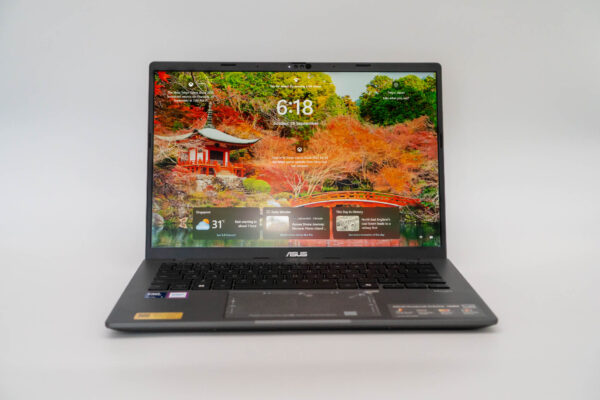
ASUS’s new Vivobook S14 S3407 aims to deliver next-generation performance and efficiency for the everyday user. It’s a sensible, practical machine with marathon-like battery life, but it also comes with a significant compromise. Is this the right mainstream laptop for you?
We’re at a point where laptops are getting a significant internal overhaul. The latest generation of processors from companies like Intel aren’t just about making things faster; they’re fundamentally re-architected to be smarter about how they use power. The goal is a more efficient, longer-lasting, and more responsive experience for everyday computing.
A device like the ASUS Vivobook S14 S3407 is a perfect example of this new wave. This isn’t a flashy, top-of-the-line Zenbook. The Vivobook line has always been about hitting that sweet spot of price and performance for the everyday user. It’s for students taking getting their coursework done, or the office worker hopping between meetings. This new model wraps the latest processor technology in a familiar, practical package. The question is, does this new hardware really deliver a better experience, or is it just a generational bump?
A Solid, No-Nonsense Machine
First impressions are that this is a quintessential Vivobook, and I mean that as a compliment. It has a sturdy-feeling aluminium lid and a metal-reinforced frame that avoids the plastic creakiness that plagues many laptops in this price bracket. It’s clean, minimalist, and its understated silver finish won’t draw unwanted attention in a coffee shop or a client meeting. At 1.4 kg, it’s not the lightest ultrabook out ther, but it’s certainly portable enough to carry around all day without any complaints or regrets.
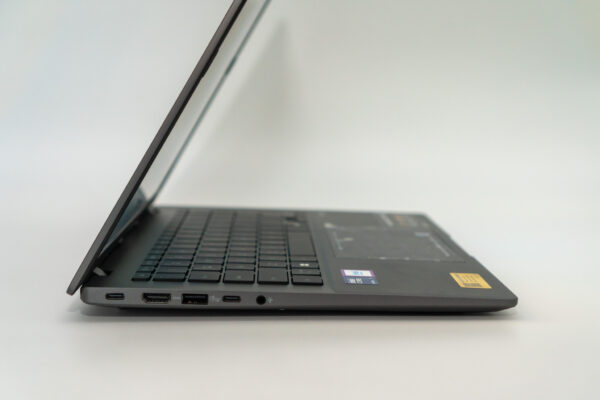
What I appreciate most is the practicality, a trait that seems increasingly rare. ASUS didn’t sacrifice essential ports for a couple of millimetres of thinness. You get two USB-C ports (sadly, not Thunderbolt 4, but they do support Power Delivery and DisplayPort), two standard USB-A 3.2 Gen 1 ports, and a full-sized HDMI 2.1 port. For anyone who gives presentations, uses an external monitor, or just wants to plug in a mouse without a fuss, this is a godsend. No dongle life for me, thank you very much.
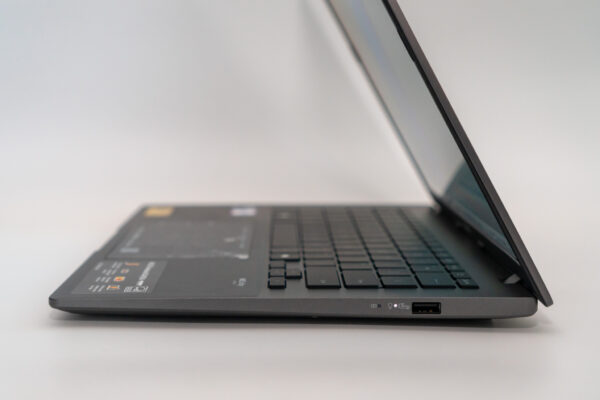
The ergonomics are equally sound. The keyboard is comfortable for long typing sessions, with a decent 1.7mm of key travel and subtly dished keycaps that guide your fingertips. It’s quiet, solid, and the single-zone backlighting is even and effective for late-night work.
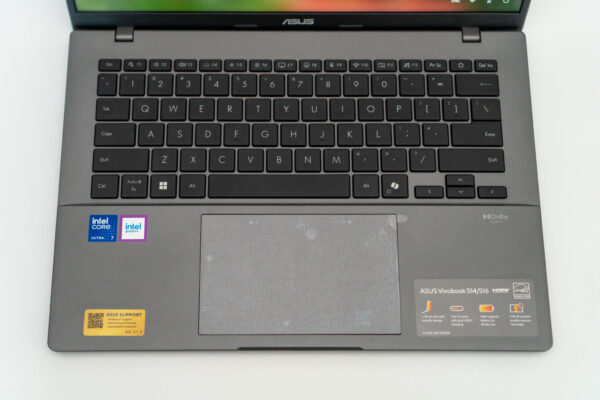
The touchpad is generously sized, smooth to the touch, and handles Windows gestures with precision. It supports ASUS’ Smart Gestures, which allow you to do tricks like adjusting volume and screen brightness by sliding your finger along the left and right edges of the touchpad respectively. You can also control media playback from the top edge, there are other screen management shortcuts too.
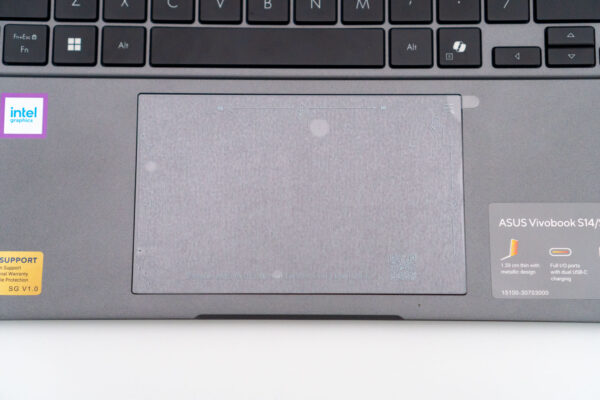
The ASUS Vivobook S14 has a workhorse build, through and through. The only minor gripe is that the chassis is a magnet for fingerprints, but that’s a small price to pay for the cool-to-the-touch metal finish.
The display on the Vivobook S14 is average at best. The 14-inch IPS panel has 1920×1200 of resolution. It’s good that it is a 16:10 aspect ratio, with 300 nits of brightness, and I like that it’s anti-glare.
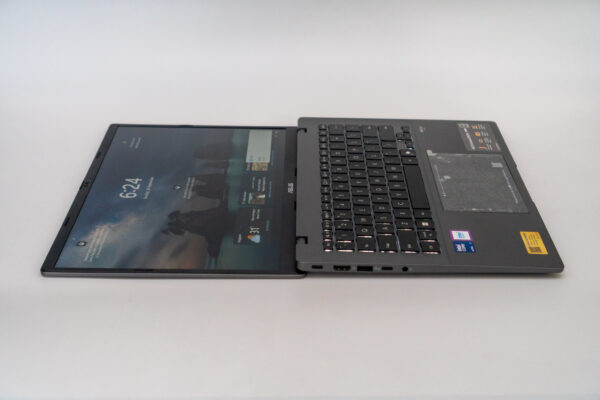
Unfortunately, the display suffers from mediocre colour output. After years of gorgeous displays from ASUS, even in their more affordable laptops, this Vivobook S14 is different. In my own testing, I found the sRGB, NTSC, AdobeRGB and P3 colour gamut coverage to be 63%, 45%, 47%, and 47% respectively. This means the colours do look muted and washed out. It is simply not suited for serious photo or video editing.
To be clear, the display is fine for any sort of basic productivity work. The anti-glare matte screen works very well to reduce glare from bright lights. However, if you are too accustomed to the punchy vibrant colours like you might get on most smartphones these days, the Vivobook S14’s screen will feel like a step-down. it is functional, but it is clearly a cost-saving measure.
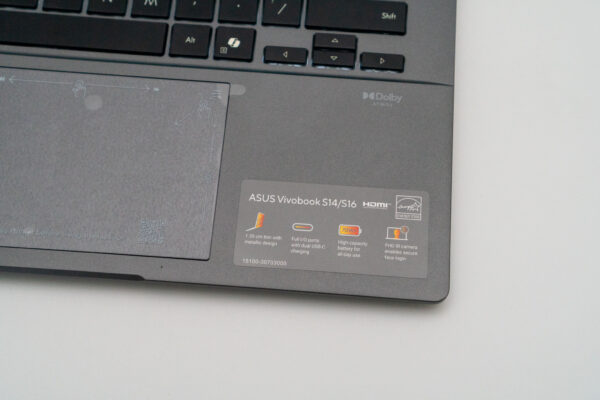
The heart of the Vivobook S14 is the new Intel Core Ultra 7 255H processor. It divides tasks between 6 Performance-cores (P-cores) for heavy lifting, 8 Efficient-cores (E-cores) for background tasks, and 2 new Low Power E-cores (LP E-cores) for when the machine is idle, all managed by the chip itself to maximize efficiency.
This new design enables some useful software features. There’s a new dedicated Copilot key for quick access to Microsoft’s assistant, and video conferencing gets a boost with Windows Studio Effects. These allow you to blur your background, automatically frame your face, and even simulate eye contact during video calls. These tasks run efficiently in the background without slowing the system down. During a long Teams call, these features remained stable, and I could multitask without the fan spinning up, something older laptops struggle with. The FHD webcam is decent enough, and the physical privacy shutter is a welcome touch for peace of mind.
The Vivobook S14 UX3407 is offered in a fixed configuration of 16 GB of DDR5 RAM (expandable to 32 G) and 1 TB of PCIe 4.0 NVMe storage.
For general performance, the laptop is consistently snappy. Booting up from cold takes less than ten seconds. Juggling a dozen Chrome tabs, Spotify, and a large Excel spreadsheet is no trouble at all. It handles everyday productivity tasks with an ease that suggests it has plenty of power in reserve. However, this is not a gaming machine or a video editing powerhouse. The integrated Intel Arc graphics are a huge step up from older integrated solutions and can handle some light gaming (think Valorant at low settings), but don’t expect to be playing the latest AAA titles on this.
The Vivobook S14, despite having the same Ultra 7 255H processor, did not perform as well as the Zenbook 14 UX3405. The PCMark 10 Extended scores are as follows:
| Battery/Balanced | Plugged-in/Balanced | |
| Overall | 5960 | 6289 |
| Essentials | 8613 | 10115 |
| Productivity | 6855 | 10423 |
| Digital Content Creation | 9381 | 10053 |
| Gaming | 4029 | 3990 |
If the display is the compromise, then the battery life is the spectacular payoff. This is where the Vivobook S14 truly shines and where the efficiency of the Core Ultra chip becomes undeniable. The combination of that processor and a large 70Wh battery delivers excellent longevity.
I put it through a typical workday: unplugged at 8 am, I spent the morning writing and browsing in a cafe, took a couple of hour-long video calls in the afternoon, and did some more light work in the evening. By 7 pm, I still had over 20% battery left. You can confidently leave the 65W USB-C charger at home for a full day of work or classes. This, for many people, is a killer feature that outweighs many other considerations.
The ASUS Vivobook S14 (S3407) is a thoroughly competent and sensible laptop. It is a tale of two halves: on one hand, you have the brilliant, forward-looking internals defined by the Intel Core Ultra chip and its stellar battery life. On the other, you have a very pragmatic, and slightly disappointing, exterior defined by its functional-but-uninspired display.
It delivers flawlessly on the fundamentals: solid performance for everyday tasks, a comfortable keyboard, a practical selection of ports, and marathon-like stamina. The new software features are a nice bonus, but the real impact of the new chip is felt in the background, enabling that incredible efficiency.
The biggest sticking point remains the display. By opting for a mediocre IPS panel instead of their excellent OLEDs, ASUS has made a clear choice. This is a machine for productivity, not for creative work or media consumption.
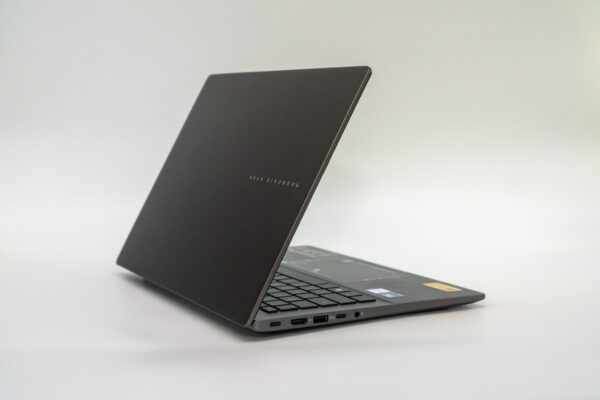
So, who is this for? If you’re a student, a mobile professional, or anyone who values reliability and battery life above all else, the Vivobook S14 is a fantastic contender. It’s a no-nonsense tool that just gets the job done without fuss. But if your work or hobbies involve a need for accurate and vibrant colours, you’ll want to look elsewhere, perhaps at one of ASUS’s other models.
The ASUS Vivobook S14 S3407 as configured in this review retails at $1,599.
View Comment Policy